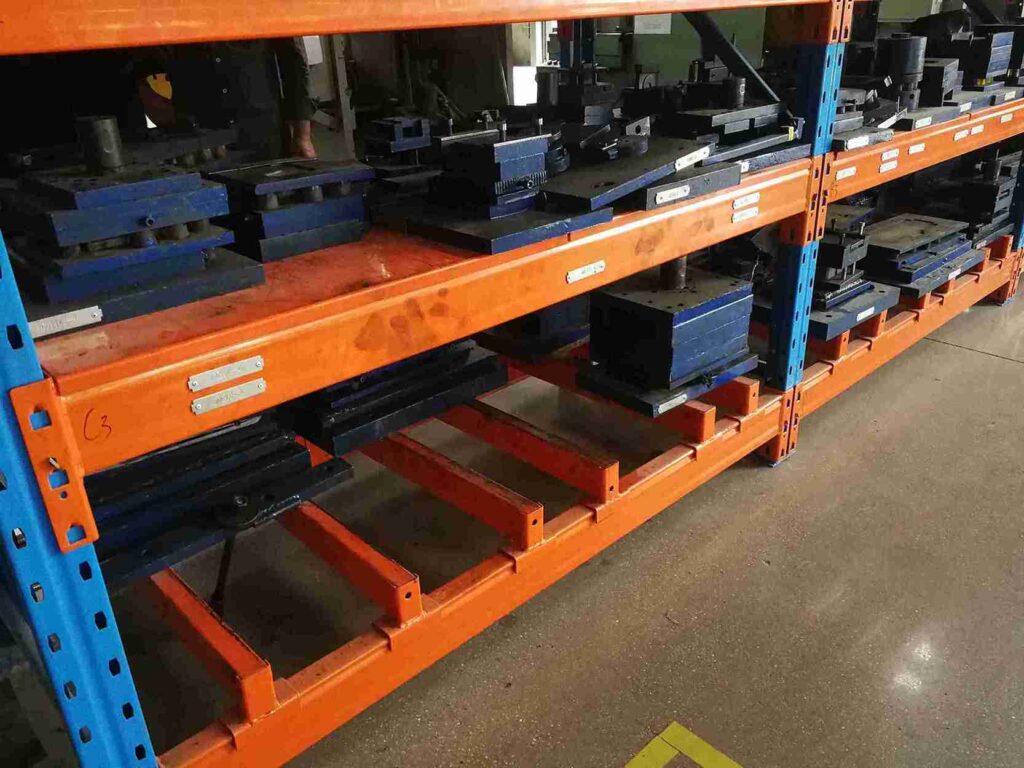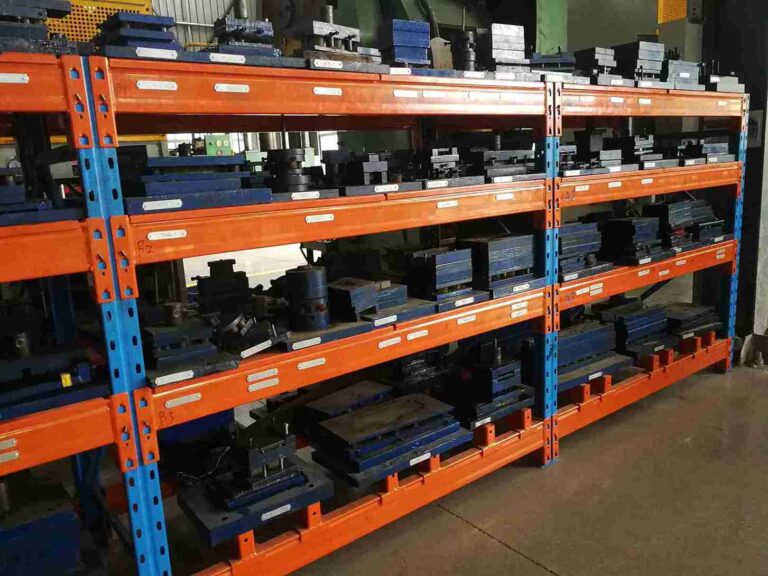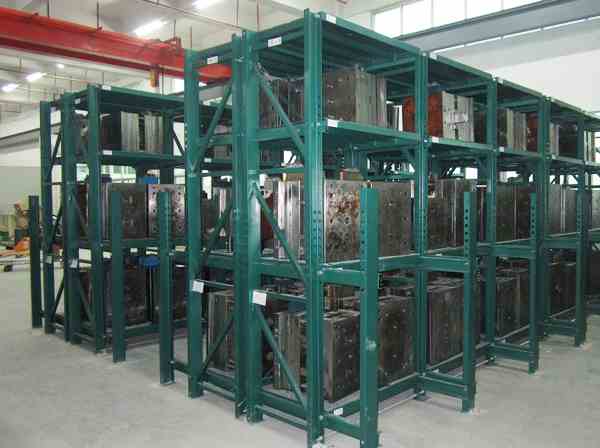📐 "First 50 Enterprise Queries Get Custom 3D Warehouse Design" Plan

The storage and management of high-value moulds, dies, and industrial tooling present a distinct set of challenges that conventional storage systems are ill-equipped to handle. This in-depth analysis examines the critical role of the heavy-duty mould racking system, a engineered solution paramount to ensuring operational safety, maximizing spatial efficiency, and protecting capital-intensive assets. This treatise will delineate the essential engineering considerations—from dynamic load capacities and structural beam configurations to the pivotal integration with Automated Guided Vehicles (AGVs) and forklifts.
Furthermore, it will elucidate the fundamental advantages of engaging with true manufacturers over mere distributors, highlighting the strategic benefits of a fabricator capable of designing systems from the ground up for flawless automation compatibility. The objective is to equip procurement managers, plant engineers, and operations directors with the requisite knowledge to specify, procure, and implement a mould storage system that not only organizes critical tooling but also serves as a cornerstone of a modern, efficient, and safe manufacturing operation.

The Imperative for a Purpose-Engineered Mould Racking System
The storage of precision tooling fundamentally differs from the storage of uniform palletized goods. Moulds and dies represent the core of production capacity—assets characterized by extreme mass, significant financial value, and extended lead times for replacement. While a standard pallet rack may offer adequate capacity for static loads, it fails to address the specific mechanical and operational demands of tooling storage. The consequences of employing an inadequate mould racking system are severe, encompassing catastrophic structural failure, irreparable damage to vital production assets, unplanned production downtime, and profound workplace safety hazards.
A professionally engineered mould racking system is designed from first principles to mitigate these risks. It transcends the concept of a simple product, representing instead a comprehensive storage solution. The core engineering philosophy extends beyond mere storage to encompass asset lifecycle management, workflow integration, and operational future-proofing. Every component, from the high-tensile upright frames to the reinforced beam connectors, is designed with the unique physical profile of moulds in mind—their asymmetric weight distribution, their requirement for secure, point-load support, and the necessity for safe, mechanized access. This specialized approach guarantees that critical production assets are protected, systematically organized, and readily accessible, thereby directly contributing to manufacturing throughput and profitability by safeguarding productive capacity.
The Operational and Financial Risks of Suboptimal Storage
Many facilities initially attempt to adapt generic pallet racking or utilize basic cantilever shelving for mould storage, a decision that constitutes a significant false economy. The inherent risks of such an approach include:
- •Critical Asset Damage: The specific points of contact on a mould are critical. Improper support can induce bending, warping, or cracking of precision-machined surfaces, effectively rendering a mould scrap and necessitating a costly and time-consuming replacement.
- •Structural Collapse: Moulds concentrate immense weight over very small surface areas. Standard warehouse beams not rated for intense point loading can deform or suffer catastrophic failure, potentially leading to a progressive collapse of the entire storage structure.
- •Workplace Safety Incidents: The manual retrieval of heavy moulds from unsuitable storage is a primary contributor to musculoskeletal injuries, crushing incidents, and other serious safety violations.
- •Operational Inefficiency and Downtime: Time expended searching for specific tooling, maneuvering it out of an inaccessible location, or managing the fallout from damage directly translates into lost production time, missed order deadlines, and eroded revenue.
Investing in a fit-for-purpose mould racking system is a strategic decision that proactively addresses these risks and elevates overall operational performance.
Core Engineering Specifications of an Industrial-Grade Mould Racking System
The term “heavy-duty” is often used indiscriminately within the industry. A true industrial-grade mould racking system is defined by a rigorous set of engineering specifications and material standards that guarantee structural integrity under maximum load. As dedicated manufacturers, our fabrication processes adhere to these specifications as a non-negotiable baseline standard.
Load Capacity and Advanced Beam Design
The beam assembly functions as the primary load-bearing component of the system. We fabricate beams with capacities typically commencing at 5,000 lbs per pair and extending to 20,000 lbs or beyond to meet the demands of the largest tooling. However, absolute capacity is merely one facet of the design; the engineering methodology is paramount.
- •Beam Profile and Material Science: Our beams are constructed from high-tensile, cold-rolled steel, utilizing a boxed or reinforced structural profile to resist torsional bending and beam deflection—common failure points under asymmetric and dynamic loads.
- •Point Load Capacity Certification: This represents the most critical performance metric. It specifies the maximum weight that can be applied to a single, discrete point on the beam—precisely how a mould sitting on a storage bar is loaded. We provide certified point load ratings for every beam classification we offer.
- •Integral Locking Mechanism: Our beam-to-upright connection systems feature a positive-locking connector that secures them to the upright frame without reliance on pins or bolts that can work loose under vibration. This creates a rigid, monolithic structure that is absolutely essential for overall stability, particularly when the system is accessed by material handling equipment.
The beam is the cornerstone of any effective mould racking system, and its design cannot be an afterthought.
Upright Frame Engineering and System Stability
The upright frames provide the foundational stability for the entire structural system. Our frames are constructed from 12-gauge and heavier high-yield steel, featuring reinforced column designs to manage the dynamic and impact forces imposed by repeated forklift and AGV interaction.
- •Frame Depth and Bracing Configuration: A deeper frame profile provides exponentially greater resistance to front-to-back moment forces, which is crucial when a heavy load is being inserted or retrieved. Internal diagonal bracing is a standard feature within the frame to absorb seismic and lateral impact forces.
- •Engineered Anchorage Requirements: Every installation mandate a site-specific engineer-certified anchorage plan. We specify the use of high-tensile, mechanical-expansion concrete anchors at every upright base plate to ensure the entire system is integrally tied into the building’s foundation, eliminating any potential for tipping or rack walk.
The integrity of the upright frame is a direct determinant of the long-term safety and durability of the entire mould racking system.
Customizable Decking Solutions for Optimal Load Support
The interface upon which the mould directly rests is a critical engineering detail. We offer a range of solutions to meet specific application needs:
- •Solid Steel Plate Decks: The premium solution for the most extreme loads. A thick, continuous steel plate deck provides unparalleled weight distribution and a perfectly stable, immovable surface for the most valuable assets.
- •Heavy-Gauge Welded Wire Mesh Decks: Offers exceptional weight distribution capabilities while permitting dust and debris to fall through, thereby maintaining a cleaner storage environment and reducing fire load.
- •Engineered Wood Decking (LVL Lumber): For certain applications, laminated veneer lumber (LVL) provides a robust, cost-effective decking solution that is still engineered to withstand significant point loads.
The selection of an appropriate decking type is a key aspect of customizing a mould racking system to precise client requirements.
Integration with Modern Material Handling: AGVs and Forklifts
A storage system does not operate in isolation. It is a fundamental component within a broader material handling ecosystem. The true benchmark of a contemporary mould storage system is its seamless interoperability with the equipment that accesses it. This is where the specification “For AGV & Forklift Access” transitions from a marketing statement to a foundational engineering discipline.
Designing for Forklift Interaction: Clearances and Structural Durability
Forklift operators are human, and human error is a calculable factor in warehouse design. Our systems are engineered to withstand occasional low-impact events and to facilitate intuitive, error-resistant operation.
- •Aisle Width Optimization: We design systems that achieve an optimal balance between high storage density and the necessary turning radius for your specific forklift models. This requires precise computational analysis to avoid cramped aisles that frequently lead to product and rack damage.
- •Integrated Impact Protection: A core component of our upright assembly is the inclusion of heavy-duty column guards (or post protectors). These are not aftermarket accessories but are integral to the design, engineered to absorb and dissipate the energy of an impact, thereby protecting both the structural integrity of the racking and the forklift itself.
- •Beam Height and Operator Visibility: We strategically position beams and often recommend high-visibility safety coatings to ensure clear sightlines for operators, significantly reducing the probability of accidents.
A well-conceived mould racking system anticipates and mitigates the realities of human-operated forklift traffic.
Precision Engineering for Fully Automated AGV Access
Integration with Automated Guided Vehicles (AGVs) and automated forklifts represents the apex of warehousing efficiency and requires a degree of precision unattainable with off-the-shelf racking solutions.
- •Pin-Point Positional Accuracy: AGVs rely on lasers, inertial guidance, or vision systems to position themselves within millimeter-level tolerances. Consequently, the mould racking system must be installed with absolute precision. Every upright must be perfectly plumb and aligned, and every beam must be perfectly level. As manufacturers who frequently oversee installation, we guarantee and certify these tolerances.
- •Systems Integration and Positioning Aids: We can integrate features such as RFID tags or fiduciary markers directly into the racking design. These provide absolute positional data to the AGV’s control system, ensuring it approaches the exact, predetermined location with flawless repeatability.
- •Dynamic Load and Structural Rigidity Analysis: The engagement and disengagement of an AGV’s lift mechanism impart unique dynamic forces on the rack structure. Our systems are specifically engineered for this type of dynamic loading, ensuring long-term stability and preventing any measurable deflection that could misalign the AGV’s programmed navigation and retrieval routines.
Designing a mould racking system for automation necessitates an engineering mindset that extends far beyond traditional storage concepts.
The Manufacturing Advantage: A Critical Differentiator
The market is replete with distributors and resellers who primarily engage in the importation and sale of catalog-specification racking. There exists a profound and consequential difference between these entities and a true manufacturer.
In-House Engineering and Custom Fabrication Capabilities
When you engage our services, you are not selecting from a limited catalog of pre-defined options. You are commissioning our internal engineering team. We design the system around your specific mould profiles, your facility’s dimensional constraints, and your existing material handling equipment. We possess the capability to create unique beam profiles, custom storage depths, and special reinforcements that a distributor cannot source. This results in a storage system that is perfectly optimized for your operation, not a compromise based on available stock.
Direct Oversight of Quality and Material Specifications
We maintain direct control over our steel mill sources, the fabrication process, the powder-coating finish, and a multi-stage quality assurance protocol. We are not subject to the quality variances or material substitutions of a third-party factory. This results in a consistent, high-quality product that meets the exacting standards required for heavy-duty, automated industrial applications. The reliability of a mould racking system is directly tied to the quality of its raw materials and fabrication.
Seamless Project Management from Concept to Completion
As a single-source manufacturer, we assume responsibility for the entire project lifecycle. Our integrated process typically encompasses:
- 1.Consultation & Data Collection: We conduct a detailed analysis of your requirements, including mould weights, dimensions, and equipment specifications.
- 2.Layout & Engineering Design: Our in-house professional engineers create detailed CAD drawings and structural calculations sealed by a Professional Engineer (P.E.).
- 3.Fabrication: We manufacture all components to exact engineering specifications within our controlled facilities.
- 4.Certified Installation: Our trained and certified installation teams execute the plan with precision, ensuring perfect alignment—especially critical for AGV-integrated systems.
This turnkey approach eliminates finger-pointing between separate entities and ensures single-point accountability for the entire project. The choice of a mould racking system partner is ultimately a choice between a commodity supplier and a solutions provider.
Selecting a Manufacturing Partner: A Due Diligence Checklist for Procurement
When evaluating potential heavy-duty mould racking manufacturers, it is imperative to ask the following questions to assess their capabilities and ensure a successful partnership:
- •Can you provide certified point load calculations and structural seals for your proposed design?
- •Do you employ in-house professional engineers to stamp and certify design drawings?
- •What is your documented process for ensuring and verifying AGV integration tolerances during installation?
- •Can you provide detailed case studies or client references from projects involving automation integration?
- •What is the specified composition, yield strength, and thickness of the steel used in your beams and uprights?
- •How does your mould racking system accommodate future reconfiguration or facility expansion?
- •Can you provide a detailed Total Cost of Ownership (TCO) analysis, moving beyond simple upfront pricing?
This checklist serves as a vital tool for discriminating between true manufacturers and mere distributors of a mould racking system.
The Mould Racking System as a Strategic Operational Hub
A modern mould racking system serves a function far more strategic than passive storage. When meticulously designed and integrated, it evolves into the operational core of your tooling management process.
Inventory Management and Digital Traceability
By dovetailing the physical racking design with a Warehouse Management System (WMS) or Enterprise Resource Planning (ERP) system, each storage location becomes a digitally addressable asset. This enables the instant location of any tool, the tracking of usage history, and the automation of preventive maintenance scheduling. An intelligently designed mould racking system thus becomes the physical anchor for a digital twin of your warehouse operations.
Workflow Optimization and Lean Manufacturing Principles
The physical layout of the mould racking system can directly influence production efficiency. By strategically positioning high-use moulds in prioritized locations near production cells or designing storage hierarchies based on usage frequency, it is possible to dramatically reduce setup and changeover times (SMED), a cornerstone of lean manufacturing philosophy. The correct mould racking system acts as a powerful enabler for waste elimination and enhanced Overall Equipment Effectiveness (OEE).
Contributing to a Proactive Safety Culture
A well-designed, well-maintained mould racking system significantly enhances workplace safety by eliminating manual handling, providing clear and safe access aisles, and reducing the need for precarious overhead retrieval. It demonstrates a tangible corporate commitment to employee safety and well-being, which in turn boosts morale and reduces turnover.
Conclusion: A Foundational Investment in Operational Excellence
The selection of a mould racking system is a strategic capital investment that will impact your operational safety, efficiency, and profitability for the entirety of its service life. It is not a transactional purchase of a commodity but a critical investment in your facility’s operational infrastructure. By partnering with a true manufacturer that possesses a deep understanding of the intricacies of heavy-duty storage and the precise requirements of AGV and forklift integration, you secure far more than steel shelving.
You gain a holistic, engineered solution designed to protect high-value capital assets, streamline material workflows, and seamlessly integrate into the automated smart factories of today and tomorrow. This investment yields continuous returns through risk mitigation, spatial optimization, and the flawless execution of production cycles. Selecting the appropriate mould racking system is, therefore, the establishment of a foundation for long-term operational resilience and competitive advantage.
*
Frequently Asked Questions (FAQs)
1. What is the typical lead time for a custom-engineered mould racking system?
Lead times are contingent upon project scope and complexity. A standard system may be ready for shipment within 3-4 weeks. A large-scale, fully customized project requiring detailed engineering analysis and automation integration planning may require 8-12 weeks from final design approval to shipment. We provide a firm and detailed timeline during the project proposal and quotation phase.
2. How is installation managed, and is it included within the project scope?
We mandate professional installation for all systems, particularly those designed for automated AGV access where millimeter-level tolerances are non-negotiable. We provide a comprehensive turnkey service that includes installation by our own certified and trained crews. This service can be bundled into the main project quotation or provided as a distinct, detailed line item. For clients utilizing their own certified installation teams, we provide exhaustive installation manuals and engineering drawings.
3. Is the mould racking system reconfigurable or relocatable to accommodate future operational changes?
Yes. A fundamental advantage of a bolted, structural mould racking system is its inherent modularity. Beams can be effortlessly repositioned to adjust shelf heights, and entire system bays can be disassembled and relocated to new areas within the facility. It is critical that any significant reconfiguration be reviewed and approved by a qualified engineer to ensure the new layout maintains full structural integrity, particularly for the extreme point loads associated with mould storage.
4. What distinguishes a dedicated mould racking system from a cantilever racking system?
While both systems are designed for non-palletized storage, their engineering philosophies differ significantly. Cantilever racks, which utilize arms extending from a single column, are optimal for long, bulky items like pipe, lumber, or sheet metal. A mould racking system is specifically engineered for intense, concentrated point loadsand typically employs a two-post (pallet rack) structural design with massively reinforced beams to support the immense weight of a mould focused on a very small footprint. The applications and engineering specifications are distinct.
5. Do you offer specialized corrosion-resistant finishes for environments that are not climate-controlled?
Absolutely. While a standard electrostatic powder-coating finish provides excellent durability for most indoor industrial environments, we offer advanced finishing solutions for harsh operating conditions, such as foundries, plating facilities, or coastal plants. Options include high-performance epoxy-based coatings or hot-dip galvanization, which provides the maximum level of corrosion protection to ensure the long-term structural integrity and service life of the system.
Welcome to contact us, if you need warehouse rack CAD drawings. We can provide you with warehouse rack planning and design for free. Our email address is: jili@geelyracks.com



